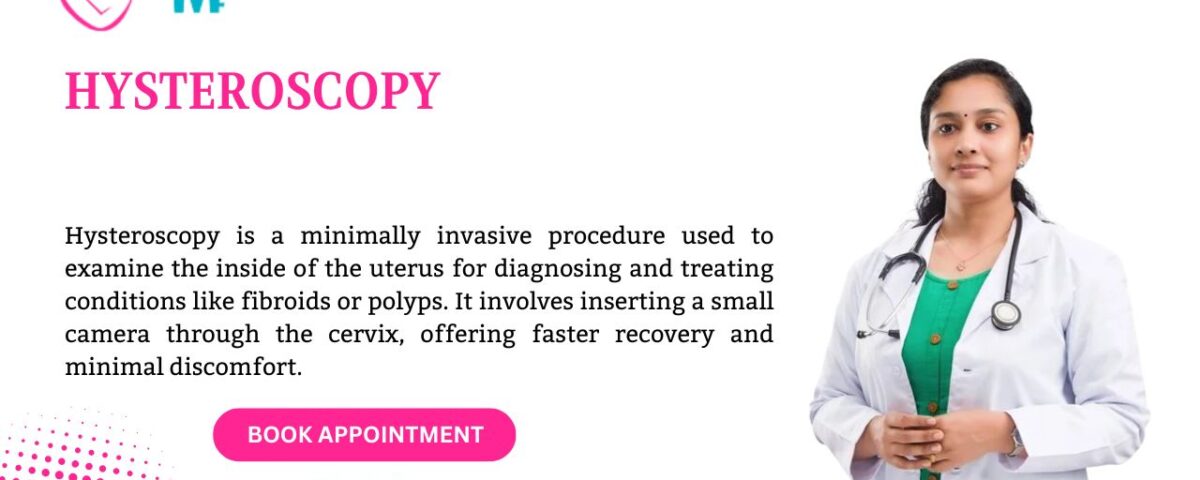
Egg donation cost in Delhi
January 10, 2025
What is the Cost of IVF in Delhi NCR
January 10, 2025In the intricate landscape of assisted reproductive technologies, the pursuit of successful fertility treatments has led to the refinement and integration of various medical procedures. Among these, Hysteroscopy has emerged as a pivotal diagnostic and operative tool, offering valuable insights and interventions to enhance the success of IVF. This minimally invasive surgical procedure provides a direct visual examination of the uterine cavity, allowing fertility specialists to identify and address factors that may impede successful embryo implantation and pregnancy.
Hysteroscopy’s significance lies in its dual role – as a diagnostic procedure, it unveils the intricacies of the uterine environment, pinpointing issues such as polyps, fibroids, or adhesions that may compromise fertility. Simultaneously, as an operative procedure, hysteroscopy enables immediate intervention to correct these identified abnormalities, creating an optimal setting for successful conception.
As couples progressively go to IVF to satisfy their fantasies of life as a parent, the fuse of hysteroscopy into fruitfulness treatment plans has turned into a foundation in streamlining results. This article digs into the complex parts of hysteroscopy about Select IVF, investigating its advantages, contemplations, and the groundbreaking job it plays in directing people on their excursion to build a family. From expanded pregnancy rates to a diminished gamble of unsuccessful labor, hysteroscopy arises as an encouraging sign, enlightening the way to effective fruitfulness medicines for those exploring the unpredictable scene of a helped generation.

Understanding Hysteroscopy
In the intricate landscape of assisted reproductive technologies, where the pursuit of parenthood often intertwines with medical advancements, Hysteroscopy emerges as a transformative tool in the realm of fertility treatments. This minimally invasive surgical procedure offers a direct glimpse into the uterine environment, providing invaluable insights for both diagnosis and intervention. Hysteroscopy has become a cornerstone in the field of Select In Vitro Fertilization (IVF), a method tailored to the specific needs of couples facing infertility challenges.
As couples set out on the excursion of helped proliferation, the journey for understanding the subtleties of fruitfulness medicines becomes fundamental. Hysteroscopy, with its capacity to investigate the uterine cavity, addresses this need by uncovering likely boundaries to effective origination outwardly. From symptomatic assessments that uncover uterine irregularities to usable systems that redress hindrances to implantation, Hysteroscopy assumes a significant part in forming individualized and viable fruitfulness treatment plans.
Key Components of Hysteroscopy in Select IVF:
- Diagnostic Hysteroscopy: In the context of Select IVF, diagnostic hysteroscopy plays a crucial role in assessing the uterine environment before initiating fertility treatments. By visually inspecting the uterine cavity, the fertility specialist can identify potential obstacles such as polyps, fibroids, adhesions, or other abnormalities that may impede embryo implantation.
- Operative Hysteroscopy: When abnormalities are detected during diagnostic hysteroscopy, operative hysteroscopy may be recommended to address and correct these issues. Common procedures include the removal of polyps, excision of fibroids, or the division of adhesions, creating an optimal environment for embryo implantation and subsequent pregnancy.
- Endometrial Assessment: Hysteroscopy allows for a direct evaluation of the endometrium, the inner lining of the uterus crucial for implantation. Assessing the health and thickness of the endometrial lining is essential for predicting the success of IVF cycles. Any irregularities or abnormalities observed during hysteroscopy can be addressed to improve the chances of a successful pregnancy.
- Guidance for IVF Treatment Plan: The findings from hysteroscopy can provide valuable insights into formulating an individualized IVF treatment plan. Understanding the unique characteristics of the uterine environment enables fertility specialists to tailor protocols, optimizing the chances of successful embryo implantation and a healthy pregnancy.
What is Hysteroscopy?
Hysteroscopy is a procedure that uses a hysteroscope—a thin, lighted tube inserted through the vagina and cervix into the uterus—to visualize the uterine cavity. This diagnostic tool enables doctors to identify abnormalities, perform biopsies, or treat certain conditions within the uterus.
There are two main types of hysteroscopy:
- Diagnostic Hysteroscopy: Primarily used to investigate and diagnose uterine problems such as abnormal bleeding, fibroids, or structural abnormalities.
- Operative Hysteroscopy: Used to treat conditions by removing or correcting issues found during diagnostic procedures. This type of hysteroscopy can address polyps, fibroids, adhesions, and other abnormalities.
Why is Hysteroscopy Performed?
Hysteroscopy is a versatile procedure often recommended for women who experience reproductive or menstrual issues. Some of the common reasons for undergoing hysteroscopy include:
- Infertility Issues: Hysteroscopy helps identify uterine factors that might be affecting fertility, such as polyps, fibroids, or adhesions, which could impede implantation or cause miscarriages.
- Abnormal Uterine Bleeding: For women experiencing heavy or irregular bleeding, hysteroscopy provides a way to diagnose and treat potential causes like polyps, fibroids, or endometrial hyperplasia.
- Diagnosis of Uterine Anomalies: Uterine septums or other congenital abnormalities can be accurately diagnosed and, in some cases, corrected with hysteroscopy.
- Recurrent Miscarriages: Hysteroscopy can reveal structural abnormalities or adhesions that might contribute to recurrent pregnancy loss.
- Endometrial Polyps and Fibroids: The procedure enables doctors to remove polyps and fibroids that may cause bleeding or infertility.
- Adhesions or Scar Tissue (Asherman’s Syndrome): Hysteroscopy is the preferred method to diagnose and remove adhesions that might form in the uterine lining, often due to prior surgeries or infections.
By using hysteroscopy to diagnose and treat these conditions, patients can often see significant improvements in symptoms and fertility outcomes.
Preparation for Hysteroscopy
Preparing for a hysteroscopy involves both physical and mental readiness. Here’s what patients can expect:
- Timing of the Procedure: Hysteroscopy is typically scheduled during the early phase of the menstrual cycle, usually just after a woman has completed her period. This timing allows for better visibility of the uterine lining.
- Fasting and Medication: Patients may be advised to fast for a few hours if anesthesia is planned. Any regular medications should be discussed with the doctor, as certain medications might need to be paused before the procedure.
- Anesthesia: Hysteroscopy can be performed with local, regional, or general anesthesia depending on the complexity of the procedure and the patient’s comfort level. Some diagnostic hysteroscopies are done in an outpatient setting without anesthesia, while operative hysteroscopies typically require anesthesia.
- Consent and Counseling: Patients are usually counseled about the potential risks, benefits, and outcomes of the procedure. This conversation is crucial to help patients feel informed and prepared for the procedure.
The Process of Hysteroscopy
Preparation: Before a hysteroscopy, the patient may undergo a thorough evaluation to assess their medical history and ensure they are suitable for the procedure. This may involve a discussion of symptoms, a physical examination, and sometimes imaging studies.
Anesthesia: Hysteroscopy can be performed with local anesthesia, regional anesthesia, or general anesthesia, depending on the specific case and patient preferences. The chosen anesthesia ensures the patient’s comfort during the procedure.
Insertion of Hysteroscope: A hysteroscope, a thin, lighted tube with a camera on its end, is carefully inserted through the cervix and into the uterus. This can be done through the vagina without the need for incisions.
Visualization of Uterine Cavity: The hysteroscope allows the doctor to visualize the inside of the uterus on a monitor. This real-time imagery helps identify any abnormalities, such as polyps, fibroids, or adhesions.
Treatment or Biopsy: Depending on the findings, the doctor may perform various procedures during hysteroscopy, such as removing polyps, taking biopsies, or addressing other issues. These interventions can often be done during the same procedure, avoiding the need for a separate surgery.
Recovery: After the procedure, the patient is monitored briefly to ensure there are no immediate complications. Recovery is generally quick, and many individuals can resume normal activities shortly afterward. The doctor provides postoperative instructions and discusses the findings and any further recommendations.
Benefits of Hysteroscopy in Select IVF
Hysteroscopy at Select IVF offers diagnostic and therapeutic benefits, providing a minimally invasive means to examine and treat issues within the uterus. This procedure aids in identifying and addressing factors impacting fertility and reproductive health.
Increased Pregnancy Rates:
Addressing to and amending uterine irregularities through hysteroscopy has been related with expanded pregnancy rates in IVF cycles. By establishing an ideal climate for incipient organism implantation, couples going through Select IVF can encounter further developed results and a higher probability of accomplishing a fruitful pregnancy.
Enhanced Implantation Success:
Hysteroscopy allows for the removal of polyps, fibroids, or adhesions that may interfere with embryo implantation. By addressing these issues, the procedure enhances the receptivity of the endometrium, promoting successful implantation and the establishment of a healthy pregnancy.
Reduced Miscarriage Risk:
Uterine abnormalities, if left unaddressed, can increase the risk of miscarriage. Hysteroscopy, by identifying and correcting such issues, contributes to reducing the likelihood of miscarriage, providing couples with a higher degree of confidence and assurance during the IVF process.
Individualized Treatment Approach:
Hysteroscopy enables fertility specialists to adopt a personalized and targeted approach to treatment. By tailoring interventions based on the specific needs of each patient, the chances of success are maximized, and unnecessary procedures are avoided, contributing to a more efficient and cost-effective fertility journey.
What to Expect After Hysteroscopy
Post-hysteroscopy recovery is generally quick, but patients might experience mild side effects:
- Cramping and Spotting: Light cramping and spotting are common for a day or two following the procedure.
- Possible Discharge: A watery discharge, sometimes tinged with blood, may occur as the saline solution clears.
- Resumption of Daily Activities: Most patients can return to work and normal activities within 24 hours, though strenuous activity should be avoided for a few days.
- Follow-Up Care: Doctors often recommend a follow-up appointment to discuss findings and any further treatment if necessary.
Patients should contact their doctor if they experience fever, severe abdominal pain, or heavy bleeding after the procedure.
Risks and Complications of Hysteroscopy
While hysteroscopy is generally safe, like any medical procedure, it does carry some potential risks:
- Infection: In rare cases, an infection can develop in the uterus, which may require antibiotic treatment.
- Injury to Uterus or Cervix: Although uncommon, the hysteroscope may cause injury to the uterus or cervix.
- Excessive Bleeding: Some women may experience heavier-than-usual bleeding after the procedure.
- Adverse Reaction to Anesthesia: If anesthesia is used, there is a slight risk of an adverse reaction.
These risks are rare, and our team at Select IVF ensures thorough pre-procedure evaluations to minimize complications.
Hysteroscopy and Fertility Treatment at Select IVF
At Select IVF, we use hysteroscopy as a critical tool in fertility care. The procedure can identify uterine conditions that might otherwise hinder fertility treatments, such as IVF. Some common uses of hysteroscopy in fertility treatment include:
- Evaluation of Uterine Cavity Before IVF: Before starting IVF, a hysteroscopy can check for any uterine abnormalities that may affect implantation.
- Removal of Polyps and Fibroids: Polyps and fibroids within the uterine cavity can hinder embryo implantation and increase miscarriage risk. Hysteroscopy allows their safe removal.
- Correction of Uterine Septum: Women with a uterine septum can have it corrected through hysteroscopy, potentially improving fertility outcomes.
- Diagnosis and Treatment of Asherman’s Syndrome: Scar tissue (adhesions) can be removed to restore the uterine cavity, making it more receptive to an embryo.
With a team of highly skilled fertility specialists, Select IVF ensures that each patient receives customized care, leveraging hysteroscopy to maximize the chances of successful pregnancy.
Conclusion
Hysteroscopy has emerged as a valuable tool in the realm of Select IVF, offering a window into the uterine environment and providing opportunities for intervention to optimize fertility outcomes. As technological advancements continue, hysteroscopy will likely play an increasingly integral role in individualized IVF treatment plans, contributing to higher success rates and the realization of parenthood dreams for countless couples.
The integration of hysteroscopy into Select IVF underscores the importance of a comprehensive and personalized approach to fertility care. By addressing uterine abnormalities and creating an optimal environment for embryo implantation, hysteroscopy stands as a beacon of hope, guiding couples toward the realization of their dreams of starting or expanding their families.
FAQ
What is Hysteroscopy?
Hysteroscopy is like sending a tiny explorer on a mission into the uterus. Using a slender tube equipped with a light and camera, doctors can visualize and diagnose various conditions, from abnormal bleeding to fertility issues.
How is it Done?
Picture a miniature camera on the end of a thin, flexible tube. This tube, called a hysteroscope, is gently inserted through the cervix into the uterus. No incisions, no scars—just a closer look at what’s happening inside.
Why Opt for Hysteroscopy?
Wondering why someone would choose hysteroscopy? It’s a diagnostic superhero, helping doctors investigate and treat issues like polyps, fibroids, and even unexplained fertility challenges.
Is hysteroscopy painful?
Generally, hysteroscopy is well-tolerated. Some women may experience mild discomfort or cramping, but the procedure is typically brief, and any discomfort is temporary.
How long does a hysteroscopy take?
The duration varies but is usually under 30 minutes. It’s a swift exploration that can provide a wealth of information in a short amount of time.
Read Also:

